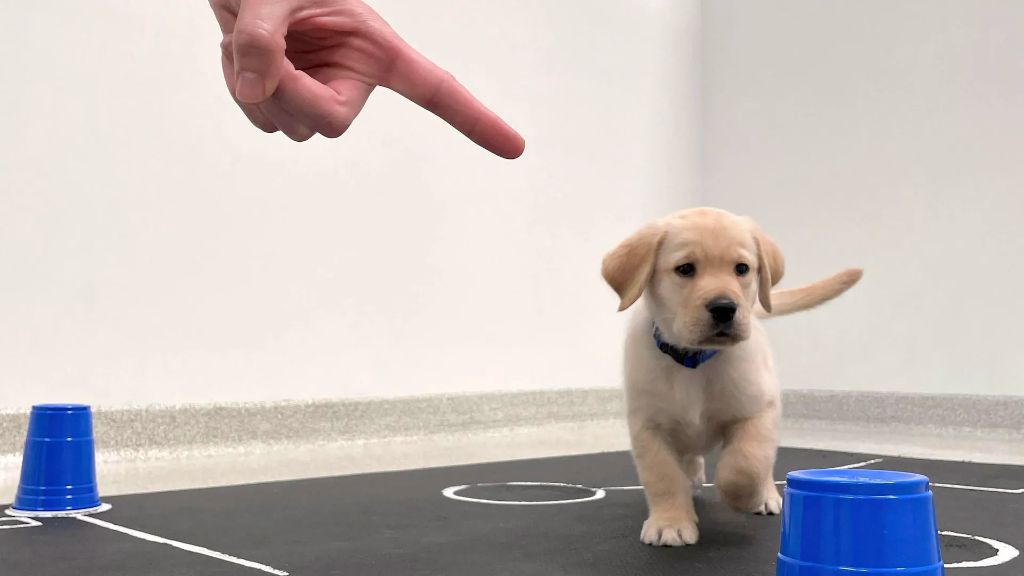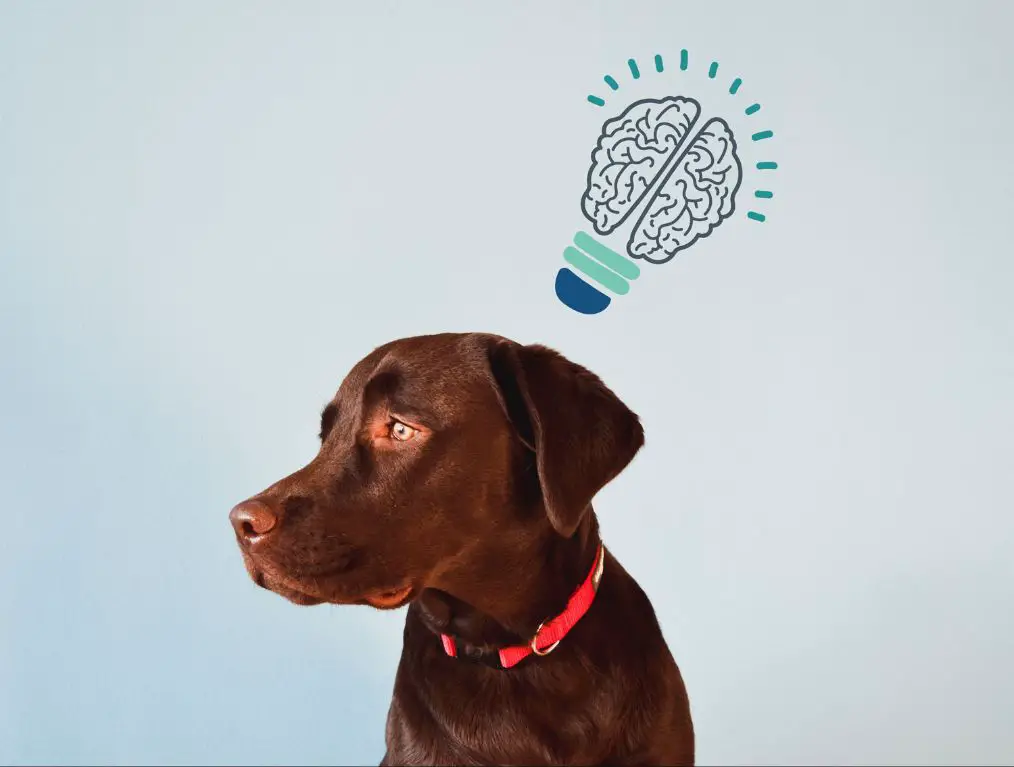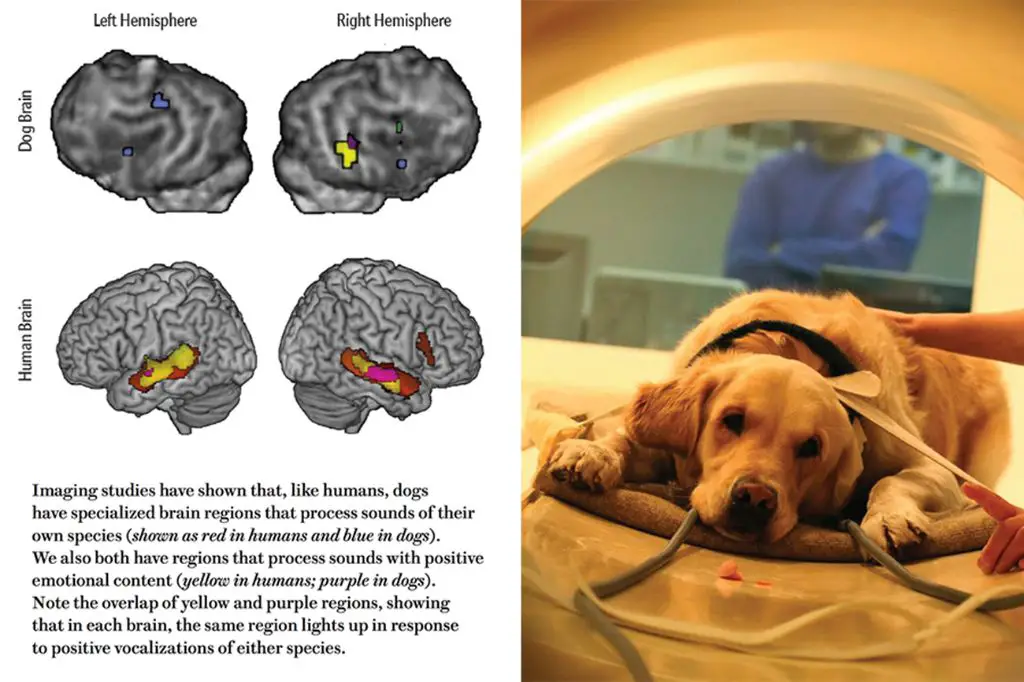Introduction
Dogs have lived alongside humans for thousands of years as pets, workers, and companions. In that time, dogs have developed unique social intelligence and communication abilities that allow them to understand human cues. Research has shown that a dog’s brain structure is wired for interpreting our gestures, emotions, and intentions in ways no other animal can. But how does the canine brain compare to the human brain in terms of intelligence and capabilities? This article examines the latest science on how the structure and function of the dog brain equates to the human brain.
History of Dog Domestication
Dogs have lived alongside humans for over 10,000 years. The earliest evidence of dog domestication comes from bones found in Europe and Siberia dating back 15,000 years. Based on genetic and archeological evidence, it’s believed that wolves began scavenging near human settlements during the late Paleolithic era. Over time, certain wolves became adapted to living close to humans, eventually evolving into the domestic dogs we know today.

This domestication process changed dog brains dramatically. Compared to wolves, domesticated dogs developed key differences in parts of the brain involved with digestion, emotion, communication, and intelligence. This allowed dogs to thrive in human settlements by better understanding human social cues and emotions. It also enabled dogs to process human food scraps more efficiently. Domesticated dogs essentially co-evolved with humans over thousands of years to become well-adapted to the human environment.
Dog Brain Structure
A dog’s brain shares similarities with the human brain but is smaller overall. Like humans, a dog’s brain features a large cerebral cortex and frontal lobe. The cerebral cortex is involved in thinking, planning, memory and other complex functions. The frontal lobe in dogs is less developed compared to humans but is still associated with personality, problem-solving and flexible learning.
Other parts of a dog’s brain include the olfactory lobe, which governs their sense of smell, the occipital lobes for vision and the temporal lobes for processing sensory input. Dogs also have deep grooves and folds in their cerebral cortex called sulci and gyri, which allow for more surface area. However, their brains contain less convolutions overall compared to humans.
While a human brain can weigh 3 pounds on average, a dog’s brain is much smaller. For example, a Labrador Retriever’s brain may only weigh 0.75 pounds. Despite the smaller size, dogs have excellent capabilities when it comes to scenting, hearing, emotion and more thanks to specialized brain regions. Their frontal cortex still allows for abstract thought, decision making and flexibility, though not at the same advanced level as humans.
Dog Intelligence and Cognition

Dogs are highly intelligent animals that excel at social cognition. Through the process of domestication over tens of thousands of years, dogs have become adept at understanding human communicative cues. Dogs demonstrate the ability to read human body language, facial expressions, and vocal tones in order to determine our moods, desires, and intentions better than even our closest primate relatives like chimpanzees.
Dogs are also excellent problem solvers. They can learn complex commands, develop innovative techniques for getting rewards, and understand the objectives of different tasks very quickly. In experiments comparing the problem solving abilities of dogs, wolves, and other canine species, researchers have found that domesticated dogs perform better than their wild cousins. This suggests domestication has selected for greater behavioral flexibility, trainability, and general intelligence in dogs.
However, dogs do not demonstrate the ability to use logic or think through multi-step problems the way humans can. Their intelligence and cognition is believed to be instinctual and tuned toward interpreting human social cues, rather than abstract reasoning abilities. So while dogs are very smart in their own way, it does not equate to human-level intelligence or cognition.
Dog Brain Development
Like humans, a dog’s brain continues to develop after birth and into adulthood. At birth, a puppy’s brain is much less developed than an adult dog’s brain.
Puppies initially rely heavily on their mother and littermates for survival. Their early behaviors are mostly instinctual and influenced by genetics. However, a puppy’s environment and experiences play a crucial role in shaping brain development.
During the first 2-3 weeks, a puppy’s brain grows rapidly, developing neural connections in response to sensory stimulation. Their eyes and ears begin opening, allowing more visual and auditory input. Puppies also start interacting with their mother, littermates and environment more actively.
Between 3-12 weeks, puppies’ brains create more complex neural networks as they build new memories and learn from experiences. This is an important socialization period, as exposure to various people, animals, objects and environments enables puppies to develop into well-adjusted adult dogs.
From 12 weeks to 6 months, puppies’ brains finalize key neural pathways. Their ability to focus, learn and respond improves dramatically during this time. House-training and basic obedience are ideal to stimulate their mental development.
An adult dog’s brain is about 70-80% developed by 9-12 months, but neural connections continue to be made into adulthood. Adult dogs can further build their cognitive skills through ongoing training, social interactions and environmental stimulation.
Human vs. Dog Brains
While humans and dogs have many similarities in brain structure, there are also some key differences that impact their relative cognitive abilities.
In terms of similarities, both human and dog brains have a neocortex – the part of the brain responsible for higher-order thinking. The neocortex allows both species to be intelligent, sentient, and conscious. Dogs may have fewer cortical neurons than humans, but their neocortex gives them the capacity for emotions, memory, and flexible learning.
However, a major difference is that the human neocortex makes up a much larger portion of our total brain mass – around 80%, compared to just 30% in dogs. This gives humans more advanced reasoning, language, imagination, and problem solving abilities. The dog brain prioritizes sensory perception and processing over higher cognition.
Additionally, communication abilities vary greatly between the species. While dogs are highly skilled at reading human body language and emotions, they cannot vocalize complex thoughts and ideas the way humans can through language. Dogs also rely more on their keen sense of smell as a primary sensory mode, whereas humans depend more heavily on sight.
In summary, while dog and human brains share similarities in their basic architecture, humans’ more expansive neocortex and language capabilities allow for abstract thought, creativity, and complex culture in a way not present in dogs. This likely gives humans a cognitive edge over their canine companions.
Brain Size vs. Intelligence

There is a common misconception that brain size alone determines how intelligent an animal is. However, scientists have found that brain size does not directly correlate with intelligence or cognitive abilities. Larger animals tend to have larger brains simply because they have larger bodies to control and larger sensory areas to process. An elephant’s brain is about 4 times as big as a human’s, but that does not mean elephants are smarter than humans.
What seems to matter more than pure brain size is the brain-to-body size ratio and the organization and structure of the brain. Humans have the highest brain-to-body mass ratio of any animal. Our larger brains have allowed us to develop advanced cognitive abilities like language, imagination, and reasoning. However, brain size alone does not tell the whole story of intelligence. For example, Neanderthal brains were slightly larger than modern human brains, but there is no evidence they were more intelligent.
The brain is made up of different regions that control distinct functions. More intelligent animals tend to have larger brain regions associated with higher-order thinking like the neocortex. The neocortex makes up about 76% of the human brain but only 30% of the dog brain. It controls sensory perception, spatial reasoning, conscious thought, and language. A bigger neocortex allows for more cognitive complexity and intelligence. So in summary, both brain size and brain organization matter for intelligence.
Dog Breed Differences
While there are some differences in intelligence between dog breeds, the differences tend to be quite small. All dogs are intelligent animals who can learn commands, understand language, solve problems, and form close social bonds with humans.
Some studies have found certain breeds like Border Collies, Poodles, German Shepherds and Golden Retrievers can learn new commands more quickly than other breeds. However, many researchers believe this has more to do with a dog’s training and environment than inherent abilities.
One analysis found that some variation in intelligence across breeds could be attributed to differences in head size and brain volume. But dog breeds with larger heads and brains don’t necessarily have higher intelligence. Small dog breeds like Chihuahuas and Toy Poodles can be just as smart as larger dogs.
Overall, most experts agree that dogs have very similar cognitive abilities across breeds. With proper training and socialization, all dogs can become loving family companions. Their ability to communicate with humans and interpret human cues is one of the most exceptional aspects of canine intelligence, regardless of breed.
Measuring Dog Intelligence
Scientists use a variety of tests and experiments to objectively measure dog intelligence and cognitive abilities. These methods allow researchers to better understand how dog minds work and compare intelligence across breeds and individuals. Some key ways dog intelligence is measured include:
Problem-solving tests – Dogs are given puzzles or challenges to solve, such as navigating obstacles to find a treat or pulling on ropes in a certain order to unlock a reward. Researchers observe how quickly and accurately dogs complete these tests.
Memory and learning tests – Dogs are tasked with learning new commands, recognizing shapes and objects, or remembering locations of hidden food after delays ranging from seconds to hours. Their memory capacity and speed of learning is quantified.
Social cognition tests – Dogs are evaluated on their ability to understand human social cues like pointing, gaze direction, and tone of voice. Their capacity for cross-species social intelligence is analyzed.
Self-control tests – Dogs are rewarded for waiting patiently rather than acting impulsively, demonstrating inhibition control. Brain scanning identifies neural areas activated during these tests.
Category learning tests – Dogs are trained to discriminate between physical objects or photographic images and group them into categories. Their conceptual learning ability is measured.
Through these diverse tests, important insights are gained into how dogs think, understand, and solve problems. This allows direct comparisons of cognitive abilities across breeds and with other species like humans and primates.
Conclusions

In summary, while a dog’s brain is much smaller than a human brain, dogs are still capable of high intelligence and advanced cognition. Key differences between dog and human brains include less developed frontal lobes in dogs, lower neuron counts, and differences in brain structure and connectivity. However, metrics like brain size and neuron counts do not directly correlate with intelligence. Dogs have evolved specific structures and abilities tuned for scent work, processing social cues, and understanding human communication. Various tests of canine intelligence have demonstrated they have excellent learning and problem solving skills, long-term memory, and the ability to understand language and commands.
It’s clear that dogs have evolved cognitive abilities that allow them to thrive in their cooperative relationship with humans. What their minds lack in complexity compared to humans, they make up for in specialized talents like scent work, focus, and obedience. Overall, a dog’s brain should not be viewed as equivalent to or not as good as a human’s, but rather as having many impressive adaptations that make dogs perfectly suited for their roles and relationships in human society.